NCERT Solutions for Class 10 Science Chapter 12 Electricity
The Class 10 NCERT Solutions for Science Chapter 12 Electricity includes all the intext and exercise questions. Class 10 Science Chapter 12 Electricity NCERT questions and answers help students to clear their doubts and to obtain good marks in Class 10 board exam. All the solutions provided in this article are strictly based on the CBSE syllabus and curriculum.
Class 10 Science Chapter 12 NCERT Questions and Answers
Class 10 Science Chapter 12 Electricity NCERT Questions and Answers are prepared by experts with a detailed explanation that will help students complete their assignments & homework. Having a good grasp over CBSE NCERT Solutions for Class 10 Science will further help the students in their preparation for board exams and other competitive exams such as NTSE, Olympiad, etc.
NCERT Solutions for Class 10 Science Chapter 12 Intext Questions
Intext Question (Page No. 200)
Question 1: What does an electric circuit mean?
Answer: A continuous and closed path of an electric current is called an electric circuit. An electric circuit consists of electric power source, wires, switches and electric devices like resistors bulbs etc.
Question 2: Define the unit of current.
Answer: When one-coulomb charge flows through an electric device in a circuit in one second, then the current flowing through the device is said to be one ampere.
Question 3: Calculate the number of electrons constituting one coulomb of charge.
Answer: Charge on one electron, 𝑒 = 1.6 × 10−19 C

Intext Question (Page No. 202)
Question 1: Name a device that helps to maintain a potential difference across a conductor.
Answer: Cell or battery maintain potential difference across a conductor.
Question 2: What is meant by saying that the potential difference between two points is 1 V?
Answer: When 1 J of work is done to move a charge of 1 C from one point to another, it is said that the potential difference between two points is 1 V.
Question 3: How much energy is given to each coulomb of charge passing through a 6 V battery?
Answer: Potential difference created by battery Δ𝑉 = 6 V
Potential difference between two points in a circuit is defined as energy required (or work done) in moving one coulomb of charge from one point to the other.
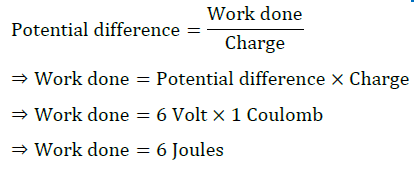
Intext Question (Page No. 209)
Question 1: On what factors does the resistance of a conductor depend?
Answer: The resistance of a resistor depends on
- Properties of the material of conductor, or resistivity of a material
- Length of conductor
- Area of cross-section of the conductor
- The resistivity of a material depends on temperature. Therefore, the resistance of a resistor also depends on the temperature of the conductor.
Question 2: Will current flow more easily through a thick wire or a thin wire of the same material, when connected to the same source? Why?
Answer: Resistance of a conductor depends on resistivity 𝜌, length 𝑙 and on the area of cross-section 𝐴 as
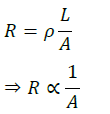
∴ when connected to the same power source, current through thick wire is more compared to thin wire of same material.
Question 3: Let the resistance of an electrical component remains constant while the potential difference across the two ends of the component decreases to half of its former value. What change will occur in the current through it?
Answer: The change in the current flowing through the electrical component can be determined by Ohm’s Law.
According to Ohm’s Law, the current is given by
I = V/R
Now, the potential difference is reduced to half keeping the resistance constant,
Let the new voltage be V’ = V/2
Let the new resistance be R’ = R
and the new amount of current be I’.
The change in the current can be determined using Ohm’s law as follows:

Therefore, the current flowing the electrical component is reduced by half.
Question 4: Why are coils of electric toasters and electric irons made of an alloy rather than a pure metal?
Answer: The resistivity of an alloy is generally higher than that of its constituent metals. Alloys do not oxidize (burn) readily at high temperatures. For this reason, they are commonly used in electrical heating devices, like electric iron, toasters etc.
Question 5: Use the data in Table 12.2 to answer the following –
Table 12.2 Electrical resistivity of some substances at 20°C
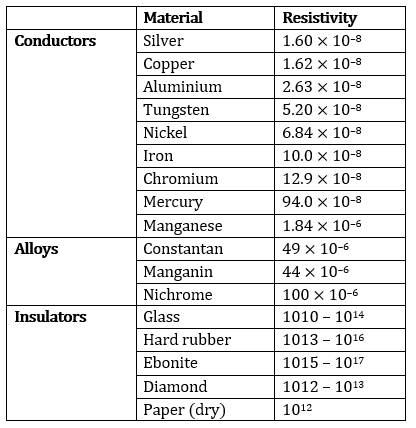
(a) Which among iron and mercury is a better conductor?
(b) Which material is the best conductor?
Answer: (a) Iron is a better conductor than mercury because the resistivity of mercury is more than the resistivity of iron.
(b) Among all the materials listed in the table, silver is the best conductor because the resistivity of silver is lowest among all, i.e., 1.60 × 10–8.
Intext Question (Page No. 213)
Question 1: Draw a schematic diagram of a circuit consisting of a battery of three cells of 2 V each, a 5 Ω resistor, an 8 Ω resistor, and a 12 Ω resistor, and a plug key, all connected in series.
Answer:
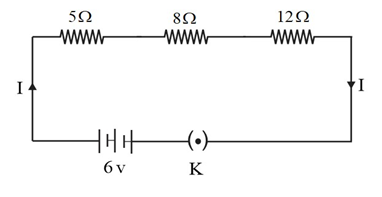
Question 2: Redraw the circuit of Question 1, putting in an ammeter to measure the current through the resistors and a voltmeter to measure the potential difference across the 12 Ω resistor. What would be the readings in the ammeter and the voltmeter?
Answer:
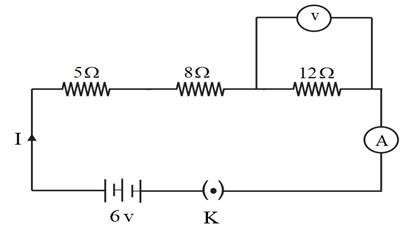
Resisters are connected in series.
So, the net resistance in the circuit = 5 Ω + 8 Ω + 12 Ω = 25 Ω
Net potential = 6 V

Now for the 12 Ω resistor, current = 0.24 A
So, using Ohm’s law V = 0.24 × 12 V = 2.88 V
Hence, the reading in the ammeter is 0.24 and voltmeter is 2.88.
Intext Question (Page No. 216)
Question 1: Judge the equivalent resistance when the following are connected in parallel –
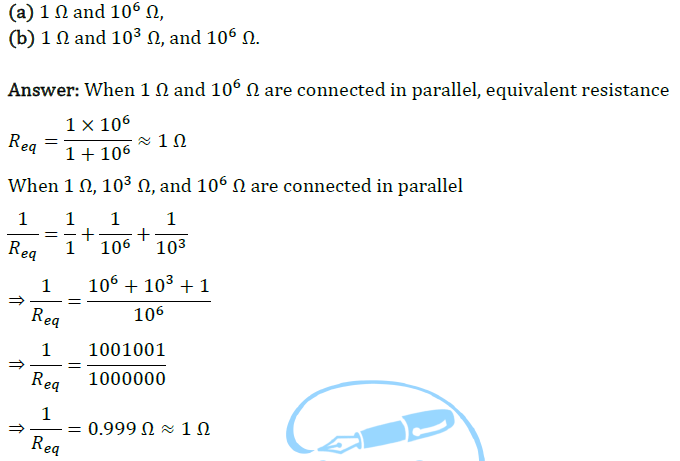
From the above two problems, when very low resistance is connected to very high resistance, the resistance of the combination will be close to low resistance.
Question 2: An electric lamp of 100 Ω, a toaster of resistance 50 Ω, and a water filter of resistance 500 Ω are connected in parallel to a 220 V source. What is the resistance of an electric iron connected to the same source that takes as much current as all three appliances, and what is the current through it?
Answer:
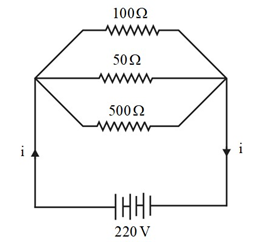
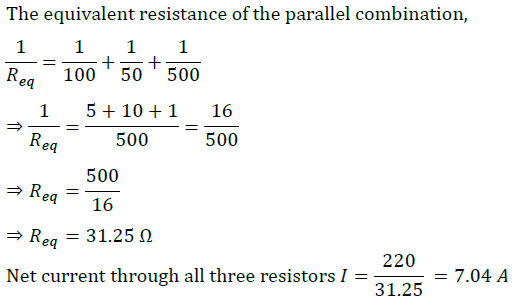
To draw the same current resistance of electric iron required is 31.25 Ω and current through it is 7.04 A
Question 3: What are the advantages of connecting electrical devices in parallel with the battery instead of connecting them in series?
Answer: To operate properly, different electric devices need a different amount of current. In series combination all the devices get the same current, whereas in parallel combination potential difference across all the resistors is same and current will be distributed according to resistance.
In series combination, if one device fails circuit becomes broken and other devices stop working. Whereas in parallel combination all devices are independently connected to mains, even if one device fails other devices continue to work.
Question 4: How can three resistors of resistances 2 Ω, 3 Ω, and 6 Ω be connected to give a total resistance of (a) 4 Ω, (b) 1 Ω?
Answer: Case 1: The circuit diagram below shows the connection of three resistors
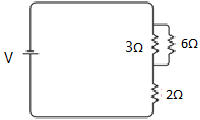
From the circuit above, it is understood that 3 Ω and 6 Ω are connected in parallel. Hence, their equivalent resistance is given by
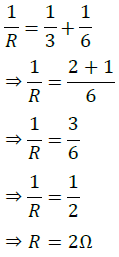
The equivalent resistor 2 Ω is in series with the 2 Ω resistor. Now the equivalent resistance can be calculated as follows:
Req= 2 Ω +2 Ω = 4 Ω
Hence, the total resistance of the circuit is 4 Ω.
Case 2: When all resistors are connected in parallel, the equivalent resistance is,
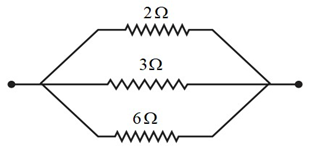
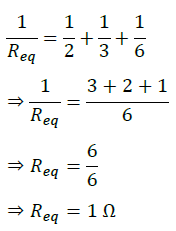
Question 5: What is (a) the highest, (b) the lowest total resistance that can be secured by combinations of four coils of resistance 4 Ω, 8 Ω, 12 Ω, 24 Ω?
Answer: Highest resistance is possible when all resistors are connected in series.

R = 4 Ω + 8 Ω + 12 Ω + 24 Ω = 48 Ω
∴ highest resistance possible is 48 Ω
Lowest resistance is possible when all resistors are connected in parallel
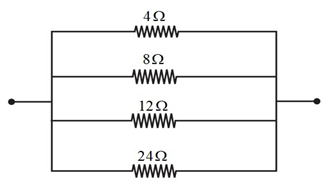
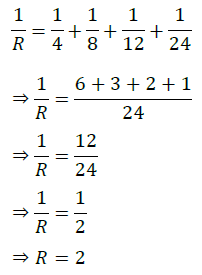
∴ Lowest resistance possible is 2 Ω
Intext Question (Page No. 218)
Question 1: Why does the cord of an electric heater not glow while the heating element does?
Answer: When the same current flows through the conducting wire and heating element, the heat generated (I2Rt) is very high in heating element compared to conducting wire. This is due to the resistance of the heating element is very high compared to the resistance of conducting wire. Thus, when same current flows through the conducting wire and heating element, heating element gets hot and glows.
Question 2: Compute the heat generated while transferring 96000 coulombs of charge in one hour through a potential difference of 50 V.
Answer: From Joule’s law of heating, the heat generated can be written as
H = V × I × t
where,
V is the voltage, V = 50 V
I is the current
t is the time in seconds,
The amount of current can be calculated as follows:

Therefore, the heat generated when 96000 coulomb of charge flows through a potential difference of 50 V is 4.8 × 106 J
Question 3: An electric iron of resistance 20 Ω takes a current of 5 A. Calculate the heat developed in 30 s.
Answer: From Joule’s law of heating, the heat generated can be written as
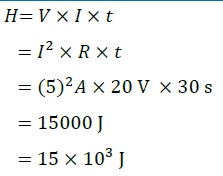
Therefore, the heat generated in 30 s is 15 × 103 J
Intext Question (Page No. 220)
Question 1: What determines the rate at which energy is delivered by a current?
Answer: Electric power is the rate of consumption of electrical energy by electric appliances. Hence, the rate at which energy is delivered by a current is the power of the appliance.
Question 2: An electric motor takes 5 A from a 220 V line. Determine the power of the motor and the energy consumed in 2 h.

NCERT Solutions for Class 10 Science Chapter 12 Exercise Questions
Question 1: A piece of wire of resistance R is cut into five equal parts. These parts are then connected in parallel. If the equivalent resistance of this combination is R′, then the ratio R/R′ is –
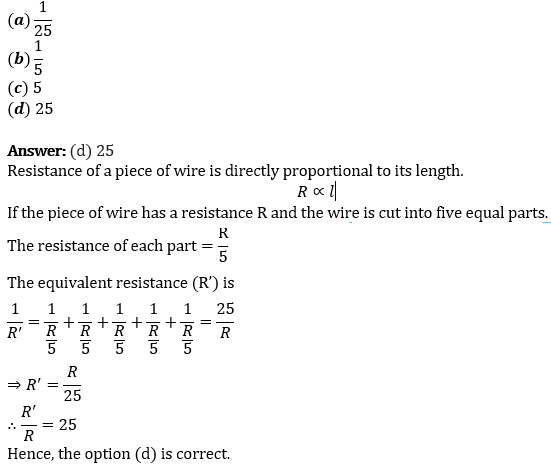
Question 2: Which of the following terms does not represent electrical power in a circuit?
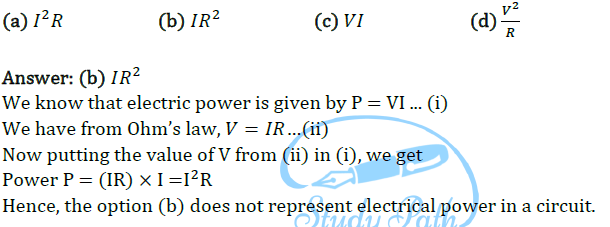
Question 3: An electric bulb is rated 220 V and 100 W. When it is operated on 110 V, the power consumed will be –
(a) 100 𝑊
(b) 75 𝑊
(c) 50 𝑊
(d) 25 𝑊
Answer: (d) 25 𝑊
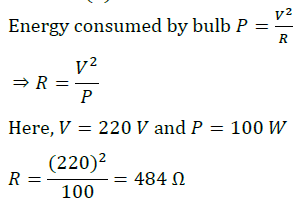
The resistance of the bulb remains constant if the supply voltage is reduced to110 V. If the bulb is operated on 110 V, then the energy consumed by it is given by the expression for power

Hence, the option (d) is correct.
Question 4: Two conducting wires of the same material and of equal lengths and equal diameters are first connected in series and then parallel in a circuit across the same potential difference. The ratio of heat produced in series and parallel combinations would be –
(a) 1:2
(b) 2:1
(c) 1:4
(d) 4:1
Answer: (c) 1:4
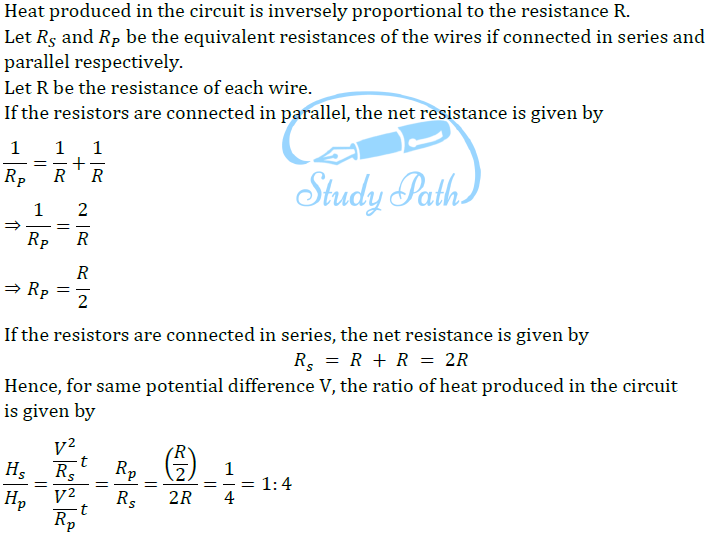
Therefore, the ratio of heat produced in series and parallel combinations is 1:4. Hence, the option (c) is correct.
Question 5: How is a voltmeter connected in the circuit to measure the potential difference between two points?
Answer: Voltmeter is always connected in parallel with circuit element to measure the potential difference across it.
Question 6: A copper wire has a diameter 0.5 mm and resistivity of 1.6 × 10–8 Ω m. What will be the length of this wire to make its resistance 10 Ω? How much does the resistance change if the diameter is doubled?
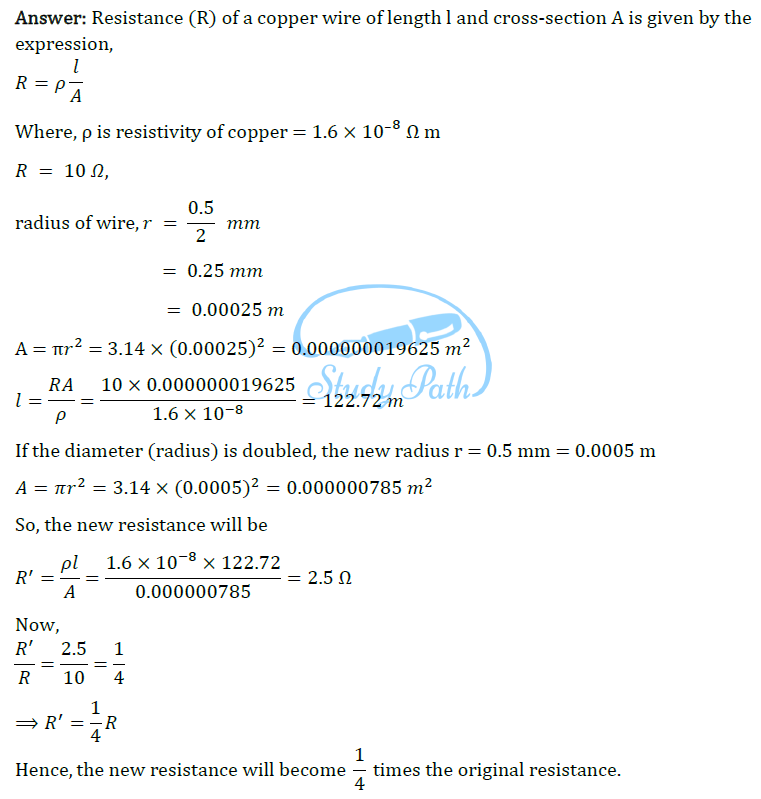
Question 7: The values of current flowing in a given resistor for the corresponding values of potential difference 𝑉 across the resistor are given below –
| I (amperes) | 0.5 | 1.0 | 2.0 | 3.0 | 4.0 |
| V (volts) | 1.6 | 3.4 | 6.7 | 10.2 | 13.2 |
Plot a graph between 𝑉 and 𝐼 and calculate the resistance of that resistor.
Answer: The plot between voltage and current is called VI characteristic. The voltage is plotted on x-axis and current is plotted on y-axis.
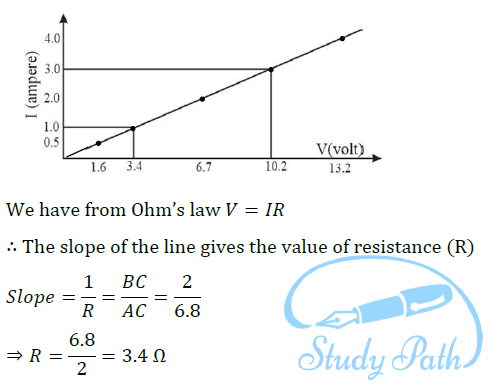
Question 8: When a 12 V battery is connected across an unknown resistor, there is a current of 2.5 mA in the circuit. Find the value of the resistance of the resistor.
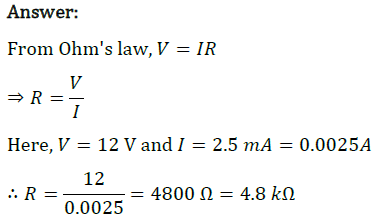
Question 9: A battery of 9 V is connected in series with resistors of 0.2 Ω, 0.3 Ω, 0.4 Ω, 0.5 Ω and 12 Ω, respectively. How much current would flow through the 12 Ω resistor?
Answer: In series combination current through all the resistors will be the same.
Resistance of resistors when connected in series is given by
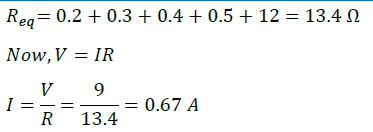
So, the current through the 12 Ω resistor will be same as 0.67 A.
Question 10: How many 176 Ω resistors (in parallel) are required to carry 5 A on a 220 V line?
Answer: Let the required number of resistors be 𝑛.
Given, Current I = 5A and Potential difference V = 220V
Now, from Ohm’s law, V = IR

Now for 𝑛 number of resistors of resistance 176 Ω, the equivalent resistance of the resistors connected in parallel is 44 Ω.
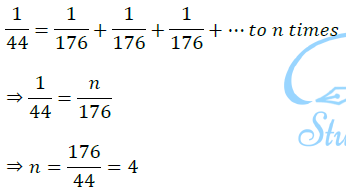
Therefore 4 resistors of 176 Ω are required to draw 5 A current on 220 V line.
Question 11: Show how you would connect three resistors, each of resistance 6 Ω so that the combination has a resistance of (i) 9 Ω, (ii) 4 Ω.
Answer: If we connect all the three resistors in series, their equivalent resistor would 6 Ω + 6 Ω + 6 Ω =18 Ω, which is not the desired value. Similarly, if we connect all the three resistors in parallel, their equivalent resistor would be
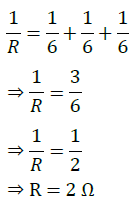
which is again not the desired value. We can obtain the desired value by connecting any two of the resistors in either series or parallel.
Case (i)

If two resistors are connected in parallel, then their equivalent resistance is
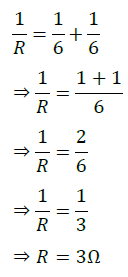
The third resistor is in series, hence the equivalent resistance is calculated as follows:
R = 6 Ω + 3 Ω = 9 Ω
Case (ii)
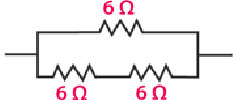
When two resistors are connected in series, their equivalent resistance is given by
R = 6 Ω + 6 Ω = 12 Ω
The third resistor is connected in parallel with 12 Ω. Hence the equivalent resistance is calculated as follows:
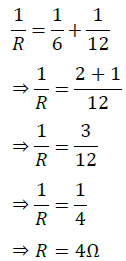
Question 12: Several electric bulbs designed to be used on a 220 V electric supply line, are rated 10 W. How many lamps can be connected in parallel with each other across the two wires of 220 V line if the maximum allowable current is 5 A?
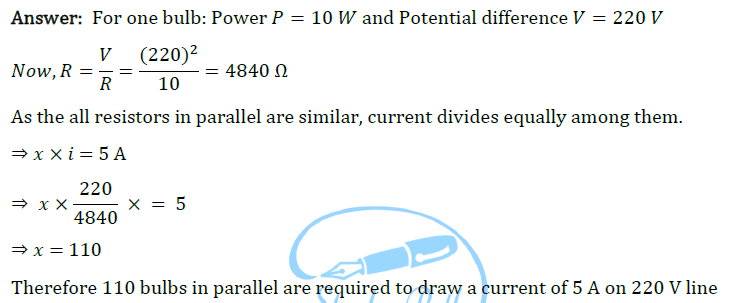
Question 13: A hot plate of an electric oven connected to a 220 V line has two resistance coils A and B, each of 24 Ω resistance, which may be used separately, in series, or in parallel. What are the currents in the three cases?
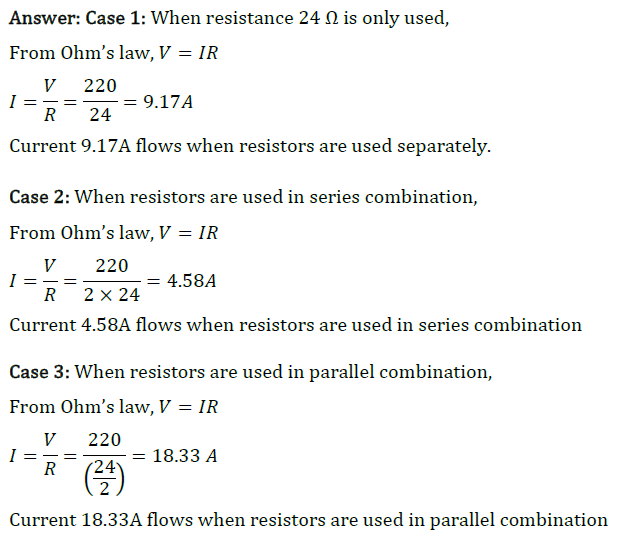
Question 14: Compare the power used in the 2 Ω resistor in each of the following circuits:
(i) a 6 V battery in series with 1 Ω and 2 Ω resistors, and
(ii) a 4 V battery in parallel with 12 Ω and 2 Ω resistors.
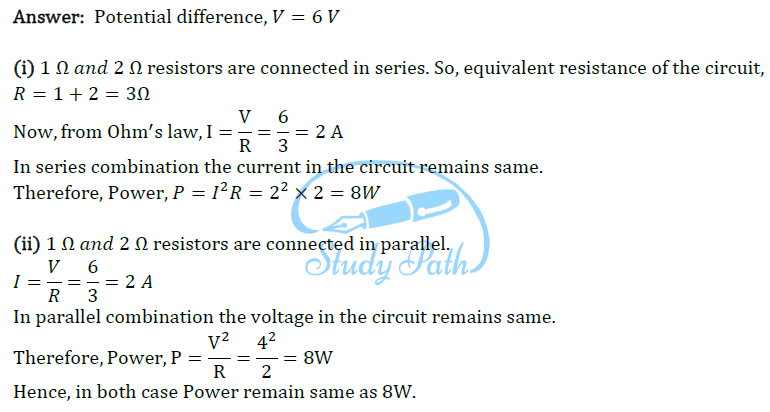
Question 15: Two lamps, one rated 100 W at 220 V, and the other 60 W at 220 V, are connected in parallel to the electric mains supply. What current is drawn from the line if the supply voltage is 220 V?
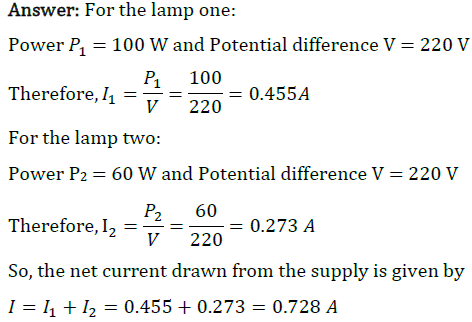
Question 16: Which uses more energy, a 250 W TV set in 1 hr, or a 1200 W toaster in 10 minutes?
Answer: Energy consumed by an electrical appliance is given by H = Pt
Power rating of TV set is 250 W
Energy consumed by TV set 1 hour = 250 × 60 × 60 = 900000 J
Power rating of toaster is 1200 W
Energy consumed by toaster in 10 minutes = 1200 × 10 × 60 =720000 J
Hence, TV set uses more energy than toaster.
Question 17: An electric heater of resistance 8 Ω draws 15 A from the service mains 2 hours. Calculate the rate at which heat is developed in the heater.
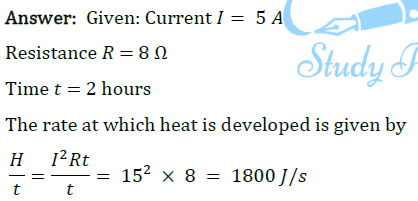
Question 18: Explain the following.
(i) Why is tungsten used almost exclusively for filament of electric lamps?
(ii) Why are the conductors of electric heating devices, such as bread-toasters and electric irons, made of an alloy rather than a pure metal?
(in) Why is the series arrangement not used for domestic circuits?
(iv) How does the resistance of a wire vary with its area of cross-section?
(v) Why are copper and aluminium wires usually employed for electricity transmission?
Answer: (i) The tungsten is used almost exclusively for filament of electric lamps because it has a very high melting point (3300°C). On passing electricity through tungsten filament, its temperature reaches to 2700°C and it gives heat and light energy without being melted.
(ii) The conductors of electric heating devices such as bread-toasters and electric irons, are made of an alloy rather than a pure metal because the resistivity of an alloy is much higher than that of pure metal and an alloy does not undergo oxidation (or burn) easily even at high temperature.
(iii) The series arrangement is not used for domestic circuits because in series circuit, if one electrical appliance stops working due to some defect, then all other appliances also stop working because the whole circuit is broken.
(iv) The resistance of a wire is inversely proportional to its area of cross-section, i.e., Resistance R ∝ (1/πr2). If the area of cross section of a conductor of fixed length is increased, then resistance decreases because there are more free electrons for movement in conductor.
(v) Copper and aluminium wires usually employed for electricity transmission because they have very low resistances. So, they do not become too hot on passing electric current.
Topics covered under Class 10 Science Chapter 12 Electricity
Below we have listed the topics discussed in NCERT Solutions for Class 10 Science Chapter 12. The list gives you a quick look at the different topics and subtopics of this chapter.
| Section in NCERT Book | Topics Discussed |
|---|---|
| 12.1 | Electric Current and Circuit |
| 12.2 | Electric Potential and Potential Difference |
| 12.3 | Circuit Diagram |
| 12.4 | Ohm’s Law |
| 12.5 | Factors on Which the Resistance of a Conductor Depends |
| 12.6 | Resistance of a System of Resistors |
| 12.7 | Heating Effects of Electric Current |
| 12.8 | Electric Power |
NCERT Solutions for Class 10 Science Chapter 12 – A Brief Discussion
Chapter Overview: Electricity has an important place in modern society. It is a controllable and convenient form of energy for a variety of uses in homes, schools, hospitals, industries and so on. In this chapter students will learn about electric current, electric circuit, circuit diagram. This chapter also covers Ohm’s law, resistor etc.